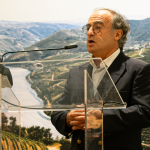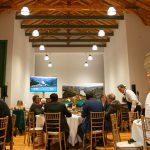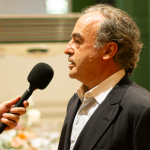Climate is a key source of uncertainty and risk for the various stakeholders in this sector, which is strategic for the national economy. Now it’s possible to mitigate said unpredictability, thanks to the Wine4Cast, a project that harnesses technology and innovation to drive transformation towards sustainability and resilience.
Wine4Cast – a project focused on developing a new forecasting system for wine production that considers the space-time dimension of production and multi-actor usability – was the winner of the +Sutentabilidade award, promoted by the Instituto dos Vinhos Douro e Porto (IVDP). According to Mário Cunha, INESC TEC researcher, this award – granted to projects that stand out for promoting environmental, economic and social sustainability in the Douro Wine Region – is an “important acknowledgement” of the work carried out “in favour of a more sustainable, innovative and resilient viticulture sector.”
Three years after the kick off, the project’s impact is clear and multidimensional. In a sector highly sensitive to climate change – leading to year-to-year fluctuations – Wine4Cast has contributed to the development of predictive tools capable of reducing uncertainty in production forecasts. This allows producers to adopt “smarter management of vineyards, wineries and other resources”, generating environmental and operational benefits.
From an economic outlook, forecasting systems like those developed by Wine4Cast provide small and medium-sized enterprises with valuable decision-support tools (for instance, in stock management). “Risk predictability, resilience, and increased competitiveness” are among the key advantages of adopting such systems, especially in a sector characterised by “fragmented supply and concentrated demand”, explained Mário Cunha. The project also had a significant social impact, by “improving cooperation between producers, technology companies, research institutions and regulatory bodies, fostering knowledge sharing and collaborative innovation.”
At a broader level, the work carried out in forecasting also helps to ensure compliance with the “maximum limits defined for designation of origin, and to prevent the loss of that status if exceeded” – crucial aspects for regions whose certified labels represent both a mark of excellence and significant economic security.
In the specific case of the Douro Wine Region, Mário Cunha highlighted that Wine4Cast has played a decisive role in enhancing the sector’s resilience and technological modernisation, driving the transition towards smarter and more sustainable viticulture, aligned with regional and European goals. This is precisely the dimension recognised by the IVDP – which, according to the researcher, underscores “the scientific and social relevance of the project, validating the contribution to the sustainable future of the Douro Wine Region and encouraging the continued application of results by all sector stakeholders.”
With numerous technical and scientific publications, the creation of vineyard phenotyping datasets, the development of optical sensors for analysing dormant bud fertility (supporting ultra-early forecasts), and AI and computer vision technologies for monitoring vineyard productivity components – even under conditions of high occlusion – Wine4Cast demonstrates the powerful impact of research and technology transfer in the agro-food sector. Several of these innovations have already been registered as industrial property.
According to the INESC TEC researcher, the project has “significantly advanced the technological and methodological level of production forecasting in viticulture, positioning Portugal as an international reference in this field.” He added that INESC TEC’s role in the project meets the Institute’s mission to “integrate science, technology and innovation, building bridges between academia, industry and public entities.” “Innovation in this area strengthens the sector’s competitiveness and sustainability, positioning Portugal as a leader in digital technologies for production forecasting in viticulture.”
Looking ahead – in a weather context expected to bring increased instability, especially across the Mediterranean – the next steps involve consolidating and scaling the tools developed, raising their technological maturity, expanding their application to other crops, and defining sustainable business models for their implementation. Another goal is to expand the project’s international reach, further reinforcing INESC TEC’s leadership in digital viticulture innovation through various research and innovation units working closely with the sector.
The researcher mentioned in this news piece is associated with INESC TEC and the Faculty of Sciences of the University of Porto






 News, current topics, curiosities and so much more about INESC TEC and its community!
News, current topics, curiosities and so much more about INESC TEC and its community!